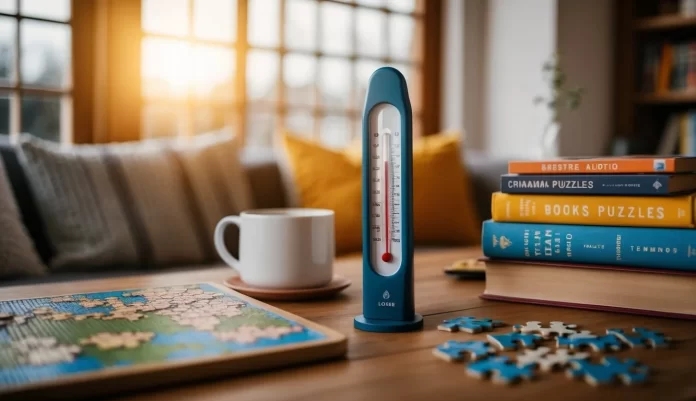
Apparently, keeping indoor temperatures between 68°F and 75°F can improve cognitive function in older adults. Why does temperature affect cognition, and what are some affordable ways to maintain this optimal range at home?.
As we age, maintaining optimal health becomes more challenging, especially when it comes to cognitive function. Recent studies have shown that keeping indoor temperatures between 68°F and 75°F (20°C to 24°C) can have a positive impact on the cognitive performance of older adults. But why does temperature matter so much for our brains? And how can you maintain this temperature range at home without breaking the bank? In this article, we’ll explore the science behind temperature and cognition, as well as provide practical tips to ensure your home environment supports brain health.
Table of Contents
Toggle1. The Science Behind Temperature and Cognition
Temperature’s Impact on Brain Function
Temperature is more than just a comfort factor—it plays a significant role in how our brain functions. Research has found that cognitive performance can be directly influenced by the environment’s temperature, especially in older adults. Here’s why:
- Cognitive Efficiency: When the temperature is too hot or too cold, it can cause the body to expend extra energy on regulating internal temperature. This reduces the energy available for the brain to function efficiently, potentially leading to decreased cognitive performance.
- Thermal Stress: Both extreme heat and cold can cause what’s called thermal stress, which negatively impacts mental sharpness. When the body is too hot or cold, it can lead to discomfort, dehydration, and confusion—all factors that hinder cognitive function.
- Optimal Temperature Range: Studies suggest that 68°F to 75°F is the most ideal range for cognitive performance in older adults. This temperature allows the body to maintain a comfortable equilibrium while also conserving energy for optimal brain activity.
2. How Temperature Affects Older Adults Specifically
Age-Related Sensitivity to Temperature
As we age, our bodies become less efficient at regulating temperature. Older adults often experience thermoregulatory dysfunction, meaning they may not perceive temperature changes as quickly or accurately as younger individuals. This can lead to:
- Difficulty staying warm in the winter: Older adults may feel chilled even when the temperature isn’t extremely cold, which can negatively impact mood and cognitive performance.
- Increased vulnerability to heat stress in summer: Seniors may struggle to cope with high temperatures, leading to dehydration, heat exhaustion, or worse, heat stroke, all of which can impair mental clarity and cognitive function.
By ensuring that indoor temperatures remain between 68°F and 75°F, older adults can avoid these stressors, leading to better mood, sharper cognitive function, and an improved overall sense of well-being.
3. Affordable Ways to Maintain an Optimal Temperature Range
1. Use Programmable Thermostats
A programmable thermostat is a cost-effective way to maintain a stable indoor temperature. These devices can be set to adjust the temperature automatically, ensuring your home stays within the optimal range throughout the day and night. By programming your thermostat to lower the temperature during the night or when you’re away, you can save on energy costs while keeping the home comfortable.
Tips for optimal use:
- Set the thermostat to adjust automatically when you wake up, when you leave for work, and when you go to bed.
- Choose models that can be controlled remotely via a smartphone app, which adds convenience.
2. Maximize Natural Light and Airflow
Using natural light to heat your home during the colder months is a simple, free way to keep temperatures in check. Open curtains or blinds during the day to let sunlight in, and close them in the evening to retain the warmth.
During warmer months, ensure that air can circulate by:
- Opening windows: Allow fresh air in during cooler parts of the day or evening.
- Using fans: Ceiling fans or box fans can help maintain airflow and create a comfortable environment without significantly increasing energy costs.
3. Invest in Energy-Efficient Heating and Cooling Systems
If you live in an area with extreme seasonal temperatures, investing in energy-efficient HVAC systems might be worthwhile. These systems can maintain consistent temperatures without driving up your electricity bills.
Consider:
- Portable air conditioners or space heaters: These are ideal for small areas or rooms where temperature regulation is essential.
- Ceiling fans: A cost-effective way to circulate air and maintain comfort.
Though these systems may involve an upfront investment, they often pay off in the long run by reducing energy costs and maintaining a comfortable indoor environment.
4. Insulate Your Home
Proper insulation in your home helps maintain a stable indoor temperature by preventing drafts and heat loss. Insulating windows, doors, and attics can keep your home warmer in the winter and cooler in the summer.
Affordable options for insulation include:
- Weather stripping around doors and windows.
- Insulated window coverings or thermal curtains to help maintain temperature.
- Foam or reflective insulation for the attic to reduce heat transfer.
These measures can significantly improve the energy efficiency of your home while maintaining the desired temperature range.
5. Dress Appropriately
In addition to adjusting the environment, wearing comfortable clothing can also play a role in maintaining an optimal body temperature. In cooler weather, layering clothes helps to trap heat, while in warmer months, breathable fabrics like cotton or linen can help you stay cool. Encourage older adults to dress in light, moisture-wicking fabrics to prevent overheating, especially during the summer.
4. Benefits of Maintaining the Optimal Temperature for Cognition
Improved Mental Performance
By maintaining indoor temperatures within the 68°F to 75°F range, older adults can experience improved cognitive function. Research has shown that this temperature range promotes clearer thinking, better memory retention, and faster reaction times. When the brain is not distracted by thermal discomfort, it can focus more effectively on tasks and problem-solving.
Better Mood and Emotional Well-Being
Temperature affects not just cognitive function but also mood. In a comfortable indoor environment, older adults may experience reduced levels of stress, anxiety, and irritability. Conversely, extreme temperatures can exacerbate feelings of discomfort, frustration, and fatigue.
Enhanced Sleep Quality
A stable, moderate temperature is also key to good sleep hygiene. Many older adults struggle with sleep disturbances, and maintaining an optimal temperature can help improve sleep quality, which in turn supports better cognitive function and overall health.
Taking Control of Your Home Environment for Better Brain Health
The connection between temperature and cognitive function in older adults is undeniable. By maintaining indoor temperatures between 68°F and 75°F, you can help support mental clarity, memory, and overall well-being. With a combination of affordable solutions—like programmable thermostats, maximizing natural airflow, and investing in energy-efficient systems—you can ensure that your home remains a comfortable environment for brain health. So, take the necessary steps today to create an optimal indoor environment and enjoy the benefits of improved cognitive performance and quality of life.







